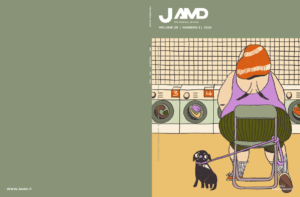Editorial
Obesity and diabetes: a challenge to be shared
JAMD 2025;28(3):165-166
Original articles
Oral Semaglutide as an opportunity for an appropriate therapeutic switch in people with type 2 diabetes: a Delphi consensus
JAMD 2025;28(3):167-177
AIMS The growing availability of therapeutic approaches to type 2 diabetes (T2D) requires a rethinking of the situations where ongoing glucose-lowering treatments could be replaced by the oral GLP1 receptor agonist (GLP1-RA) semaglutide (OS). Given the considerable number of open questions, a group of experts was convened with the aim of providing, through a Delphi consensus method, practical guidance for doctors.
METHODS A group of 13 experts developed a series of 31 statements relative to the following situations: switch from injectable GLP1-RA to OS; switch from SGLT2i to OS; switch from insulin to OS; switch from DPP4i to OS; switch from “old” oral therapies (i.e. sulphonylureas, glinides, pioglitazone, acarbose) to OS. A panel of 28 diabetologists, all operating in the Emilia Romagna region, by accessing a dedicated website, assigned each statement a relevance score on a 9-point scale. The RAND/UCLA Appropriateness Method was adopted to assess the existence of disagreement among participants.
RESULTS Panelists showed agreement for all 31 statements, all considered relevant. Panelists agreed that OS can represent in many circum tances a valuable alternative to injectable GLP1-RAs, other oral glucose-lowering drugs, and insulin.
The choice of OS is supported by its efficacy in lowering HbA1c and body weight and by the benefits on cardiovascular outcomes and all-cause mortality. Furthermore, OS can allow a simplification of therapy in patients treated with insulin.
CONCLUSION In a continuously evolving scenario, OS therapy represents an important option in the management of T2D patients.
KEY WORDS type 2 diabetes; expert consensus; oral semaglutide.
Game-based learning and Escape rooms: potential applications in diabetology medical training and field experience
JAMD 2025;28(3):178-185
Teaching methods are rapidly evolving through the integration of game-based strategies such as gamification, serious games, and game-based learning. These approaches make education more engaging, practical, and collaborative. Among them, educational escape rooms have emerged as promising tools, although not yet fully validated, to foster critical thinking, teamwork, and problem-solving skills. Diabescape is here presented as a first experience specifically designed for medical education in diabetology, rather than a validated method. It is a tabletop escape room based on real clinical cases combining puzzles, medical challenges, and collaborative tasks to actively develop clinical competencies in an immersive and interactive environment. This method was successfully tested during a training event in Sicily showing encouraging results in terms of participant engagement, collaboration, and perceived learning benefits, though objective validation remains to be conducted. Compared to traditional teaching methods, preliminary feedback from Diabescape suggests increased learner engagement. Feedback from the event confirmed high satisfaction levels and indicated its potential educational effectiveness. Although further studies are needed to confirm and quantify these benefits, our results suggest that game-based learning experiences like Diabescape could represent a modern, valid, and impactful strategy for healthcare education.
KEY WORDS Game-Based Learning; Educational Escape Room; medical education; diabescape; clinical skills.
New LEA: scenario for Italian Diabetology
JAMD 2025;28(3):186-192
The Essential Levels of Care (LEA) are healthcare services that Italy’s National Health Service (SSN) must provide to all citizens, either free of charge or with a co-payment, to ensure equity and system sustainability. Regions must comply with these minimum levels and may offer additional services using their own funds. LEA were first introduced in 2001 and are periodically updated to reflect medical advancements. A National Commission, established in 2015, is responsible for these updates. Major revisions were made in 2008 and 2017, with further adjustments through 2024. The implementation of the new service listings was postponed to December 30, 2024, due to organizational issues in the Regions.
During this transition phase, the Conference of Regional Presidents reviewed the changes affecting diabetology, focusing on a new service included in the 2017 LEA: dynamic glucose monitoring or Glycaemic Holter.
KEY WORDS LEA, diabetes, SSN, Continuous Glucose Monitoring, Glycaemic Holter.
Surveys
Protected discharge: results of a national survey
JAMD 2025;28(3):193-199
The survey focuses on transitional care interventions from hospital to community. It investigates satisfaction with the present discharge planning for people with diabetes.
The results show enough satisfaction with the present system among approximately 59% of the respondents, while the others stated they were dissatisfied.
The process may be improved, especially in terms of efficiency, health outcomes, and lastly reduced healthcare costs. The majority of respondents would choose as a feasible improvement a web-based thorough sharing of medical records, while others recommend developing new clinical pathways or strengthening telemedicine platforms.
KEY WORDS diabetes; discharge; case-management; telehealth.
Consensus
Consensus document for people with diabetes in transition from community to hospital to community. Operational proposals for managing hospitalization and protected discharge
JAMD 2025;28(3):200-208
This position statement outlines the consensus and the operational proposals for the management of people with diabetes during hospital transitions, with a particular focus on safe discharge planning. The document emphasizes the high clinical and organizational impact of diabetes, especially in older adults and patients with comorbidities. It proposes a structured approach to admission, inpatient care, therapeutic education, technology management, and post-discharge follow-up to reduce hospital readmissions and improve continuity of care. The involvement of the diabetology team, early patient and caregiver education, pharmacologic reconciliation, and integrated digital systems are highlighted as essential. New indications are provided for the perioperative and inpatient management of antidiabetic therapies, including SGLT2 inhibitors, GLP-1 receptor agonists and metformin. The ultimate goal is to implement a model of governance that ensures safe, personalized, and cost-effective care across hospital and territorial services.
KEYWORDS diabetes; inpatients; in-hospital management; perioperative management; discharge planning.
Diabetes and palliative care: a study group document
JAMD 2025;28(3):209-218
Italian legislation defines palliative care as “the set of therapeutic, diagnostic and care interventions, addressed both to the sick person and to his/her family unit, aimed at the active and total care of patients whose underlying disease, characterized by an unstoppable evolution and a poor prognosis, no longer responds to specific treatments”. This definition extends the scope not only to cancer patients but to numerous chronic-degenerative diseases. Diabetes is a problem frequently encountered in this type of patients both for the evolution of the disease and for the use of diabetogenic therapies. Despite the social and epidemiological relevance of the problem, there is a lack of specific guidelines. The aim of this article is to provide a framework of the problem and address lines usable in clinical practice.
KEY WORDS quality of life; deprescribing; sharing; caring.
From prejudice to objectivity: the impact of stigma on the clinical and social approach to obesity
JAMD 2025;28(3):220-226
Obesity, a chronic progressive and relapsing disease, is one of the main public health challenges globally, with prevalence more than doubling between 1990 and 2022 (men 4.8% vs 14.0%; women 8.8% vs 18.5%), with over 890 million adults and 160 million children classified as obese in 2022, according to data from the World Health Organization (WHO).
Despite the significant increase in prevalence, many people with obesity are not treated. This issue is a consequence of various barriers that limit access to effective care; among these, stigma, social disapproval, biases associated with obesity, lack of healthcare or insurance coverage, as well as a lack of proper training for both healthcare personnel and patients regarding the weight loss journey, treatment options, and unrealistic expectations about weight loss rates from individuals.
In particular, the prejudice against weight, the stigma, leads to actions against people with obesity that can cause exclusion, marginalization and inequality in treatment and access to care. All these factors can contribute to the difficulty experienced by the subject with obesity in adhering to evidence-based therapeutic pathways, preventing the achievement of weight loss goals.
KEY WORDS: obesity; stigma; effective communications; global changes.
Is obesity a chronic disease or a mere risk factor?
JAMD 2025;28(3):227-236
Obesity is a multifactorial condition with increasing medical, social, and economic impact. Traditionally regarded as a risk factor for various non-communicable chronic diseases, advances in pathophysiological understanding and diagnostic criteria have led to its progressive recognition as a chronic, relapsing, systemic disease. This article provides a critical review of the most recent scientific evidence, comparing the risk-factor-based perspective with the emerging view of obesity as an autonomous pathological entity.
Particular focus is given to the distinction proposed by the Lancet Commission on the Definition and Diagnosis of Clinical Obesity, which differentiates preclinical obesity (excess adiposity without clinically evident dysfunction) from clinical obesity (presence of metabolic, biological, or psychological alterations directly associated with adiposity). This conceptual shift highlights the limitations of relying solely on body mass index and supports the adoption of functional and prognostic risk stratification tools.
In this context, the 2025 EASO Framework formally defines obesity as a chronic, relapsing disease requiring integrated, structured, and individualized care. The article explores the clinical challenges of preclinical stages, the need for early intervention, the utility of staging models such as the Edmonton Obesity Staging System (EOSS), and the therapeutic potential of novel pharmacological agents, particularly incretin-based therapies.
Finally, the paper discusses the systemic implications of formally recognizing obesity as a disease within national healthcare systems, emphasizing the urgent need for its inclusion in the Italian Essential Levels of Care. Moving beyond a purely preventive approach toward a chronic care model is essential to effectively counter the obesity pandemic and mitigate its clinical and burden.
KEYWORDS clinical obesity; preclinical obesity; chronic disease; EASO framework; LEA; obesity care.
Obesity in people with diabetes AMD Annals 2024
JAMD 2025;28(3):237-254
AIM OF THE STUDY This article examines the prevalence and trends of obesity in the AMD Annals for type 1 diabetes (DM1), type 2 diabetes (DM2), and gestational diabetes (GDM). Temporal trends in obesity are also described in specific populations.
DESIGN AND METHODS Analysis of AMD Annals data from 2004 to 2024 for DM1, DM2, and GDM (2024 only), assessing differences by age, gender, region, and country of origin.
RESULTS In DM2, a progressive decline in the prevalence of obesity (BMI≥30) was documented from 2016 to 2024, despite 35% of the population still being obese. This result is likely linked to the greater use of GLP-1 RAs and SGLT2i (from 7.7% in 2016 to 77.4% in 2024), but with evidence of undertreatment (particularly for SGLT2i) in women. In DM1, however, obesity is on the rise, with an increase in prevalence from 7.8% in 2004 to 14.3% in 2024, especially in patients on multiple injection therapy and a consequent worsening of the cardiovascular risk profile. In GDM (2024), obesity is present in 25.6% of women.
CONCLUSIONS The continuing decline in the prevalence of obesity in DM2 and the current and future availability of increasingly effective weight-management medications gives us hope for the future. In DM1, it is time to recognize the presence of obesity and its associated risks in terms of complications. Obesity is a key risk factor for GDM: therefore, preventive action is needed in the general population to control this public health problem.
KEY WORDS AMD Annals, obesity, type 1 diabetes, type 2 diabetes, gestational diabetes.
The incretin revolution
JAMD 2025;28(3):246-251
Obesity is now recognized as a chronic, relapsing, and heterogeneous disease, prompting a paradigm shift in therapeutic strategies. Incretin-based therapies, specifically GLP-1 receptor agonists and dual GIP/GLP-1 receptor agonists, have redefined the management of obesity through their potent and sustained weight loss effects and broad impact on associated comorbidities. This narrative review synthesizes the latest evidence from large randomized clinical trials, such as SELECT, STEP, SURMOUNT, SUMMIT, and ESSENCE, highlighting improvements not only in weight outcomes but also in cardiovascular risk reduction, renal function preservation, reversal of steatohepatitis, and symptom relief in osteoarthritis and obstructive sleep apnea. These results support a new therapeutic model in which incretin-based treatments are selected based on clinical phenotype and implemented proactively to modify disease trajectories. Emphasis is placed on integrating these therapies into accessible and structured healthcare pathways.
KEY WORDS obesity; incretins; semaglutide; tirzepatide; GLP-1 receptor agonist; GIP/GLP-1 dual agonist; clinical trials; metabolic comorbidities; pharmacotherapy; personalized medicine.
Nutrition in the new therapeutic context
JAMD 2025;28(3):252-258
Obesity is a complex and multifactorial disease whose treatment is undergoing profound changes. The introduction of increasingly effective anti-obesity drugs (AOMs), capable of inducing weight loss previously achievable only with bariatric surgery, creates new scenarios that require modifications of therapeutic approaches. However, because of this “pharmacological revolution” we need to rethink and enhance nutritional intervention as well, considering the multiplicity of factors that cause obesity, including genetic, environmental, psychological and behavioral factors. To get the maximum benefit, nutritional therapy and drug therapy must be synergistically integrated into the selected patients. Medical nutrition therapy that also allows long-term sustainability remains the key to therapeutic success: medications should be used, in the right patients, as a complement to improve motivation and adherence and to enhance weight loss, not as a substitute for nutritional changes. Nutritional goals in the AOM era include: preventing loss of lean mass, mitigating the gastrointestinal effects of medications, preventing nutritional deficiencies, and encouraging the progressive integration of behavioral strategies that can consolidate clinical benefits and prevent eating disorders.
KEY WORDS obesity; medical nutrition therapy; anti-obesity drugs; diet; weight loss.
Bariatric surgery: when and for whom?
JAMD 2025;28(3):259-271
Obesity is a chronic, multifactorial disease representing a major global health challenge and is closely linked to numerous comorbidities, including type 2 diabetes mellitus (T2DM), arterial hypertension, dyslipidemia, and obstructive sleep apnea syndrome (OSAS). Historically regarded as a “last-call” intervention for weight loss, bariatric surgery has progressively evolved into the broader concept of metabolic surgery, which leverages the neuroendocrine and metabolic effects of surgical procedures. These effects include modulation of hormonal secretion (GLP-1, PYY, ghrelin), improvements in insulin sensitivity, and changes in gut microbiota composition.
Recent guidelines, including the 2023 SICOB recommendations, have expanded the indications for surgery to patients with a BMI of 30–34.9 kg/m² in the presence of uncontrolled comorbidities, emphasizing the need for a structured, multidisciplinary approach to patient selection, preparation, and long-term follow-up. Various surgical techniques — such as sleeve gastrectomy, Roux-en-Y gastric bypass, mini-gastric bypass, and duodenal switch — allow treatment strategies to be tailored to the patient’s clinical profile and metabolic needs.
In T2DM, metabolic surgery has demonstrated remission rates superior to any medical treatment, delivering long-term benefits in glycemic control and a reduction in cardiovascular mortality. Despite the recent advances in pharmacological therapies, particularly GLP-1 receptor agonists and GIP/GLP-1 receptor agonists, surgery remains a unique component of obesity management, due to its effectiveness in promoting sustained weight loss and metabolic improvement. Integration between surgical and pharmacological strategies is now essential to offer individualized treatment pathways, aimed at improving health outcomes and quality of life.
KEY WORDS metabolic surgery; severe obesity; DM2 remission; complications.
Systemic benefits of weight loss: impact on cardiovascular risk
JAMD 2025;28(3):272-276
Weight loss has been increasingly recognized as a key therapeutic strategy for reducing cardiovascular risk, through dose-dependent and multifactorial mechanisms. Even modest weight reduction (5–10%) significantly improves various cardiometabolic risk factors, while losses exceeding 10–15% are associated with broader benefits, including mortality reduction. Evidence from clinical trials such as DPP, Look AHEAD, and SOS confirms the impact of weight loss on glycemia, lipid profile, hepatic steatosis, and obstructive sleep apnea. Furthermore, novel incretin-based anti-obesity therapies (semaglutide and tirzepatide) have demonstrated significant reductions in major cardiovascular events and heart failure, with early effects partially independent of weight reduction.
Both randomized and real-world studies indicate that these agents also modulate ectopic fat, systemic inflammation, and prothrombotic state, reshaping cardiovascular prevention strategies in the obese population.
KEY WORDS obesity, mortality, heart failure, cardiovascular prevention, GLP1-Ras.
Other target organs. Focus on MASH, OSAS and cancer: relevant complications for overall clinical risk
JAMD 2025;28(3):277-291
Obesity carries significant risks on several organs and tissues; in the present review we discuss the metabolic risk on the hepatic parenchyma, the risks associated with sleep apnea syndrome and the risk of cancer. Steatotic liver disease has been extensively investigated in the past 25 years. After a lot of negative studies, we now have several candidate drugs that, either by means of a direct action on the liver or via a massive and sustained weight loss, proved able to reduce the risk of progression of the natural history of liver disease towards cirrhosis and, possibly, to hepatocellular carcinoma. Similarly, the use of GLP-1 receptor agonists, double (GLP-1/GIP or GLP-1/Glucagon) and triple GLP-1/GIP/Glucagon agonists have opened a new era also in the treatment of comorbidities. Finally, bariatric (metabolic) surgery remains a possible intervention to reduce mortality risk. In the general population, however, only prevention strategies may be feasible to reduce the overall risks.
KEY WORDS fatty liver; fibrosis; cirrhosis; obstructive apnea; snoring; cancer; weight loss; GLP-1 receptor agonists; bariatric surgery; liver transplantation.
Type 2 diabetes in obese people: between prevention and remission
JAMD 2025;28(3):292-308
Obesity and Type 2 Diabetes (T2DM) often coexist: weight management plays a key role in T2DM prevention and remission. Early and significant weight loss can be obtained by intensive lifestyle intervention (ILI), metabolic surgery or drug therapy.
ILI is effective in T2DM prevention in 42-58% but it’s difficult to achieve and maintain in the long term. Metabolic surgery permits remission in 87% of obese subjects with prediabetes and reduces microvascular complications; nevertheless, weight regain occurs in 20-25%. Incretin-based drugs for obesity prevent 66-92% cases of T2DM and evidence shows cardiovascular benefits, even if advantages are partially lost after drugs discontinuation.
T2DM remission definition is controversial and debated. ILI permits up to 86% of remission with weight loss >15 kg, but it lacks in durability; metabolic surgery is significantly superior in remission and prevention of T2DM complications than non-surgical interventions.
Incretins introduce the concept of pharmacological remission: semaglutide allows to reach values of glycated hemoglobin (HbA1c) <6.5% in 62%, whereas tirzepatide in 81-86% of people affected by obesity and diabetes; tirzepatide is associated with HbA1c < 5.7% in 31-52%. New perspectives come from incretin-based drugs which are still under study.
In the near future, normoglycaemia should be an achievable goal in obese people affected or at high risk of T2DM.
KEY WORDS obesity; intensive lifestyle intervention; metabolic surgery; incretin drugs; pharmacological remission.
A territorial network against obesity in the USL Toscana Nord Ovest
JAMD 2025;28(3):309-317
Obesity is a chronic, non-communicable disease with a high prevalence and recurrence rate, often associated with severe comorbidities such as type 2 diabetes, cardiovascular disease, and sleep apnea. It poses a growing burden on healthcare systems and public health resources.
METHODS In the Tuscany North-West Health Authority (ATNO), which encompasses approximately 1.2 million residents, over 130,000 individuals are estimated to live with obesity, with an additional 178,000 overweight. Due to a limited offer of structured care pathways, especially for bariatric surgery, a multidisciplinary inter-company network was established. This project, led by the ATNO Corporate Diabetology Unit in collaboration with the University Hospital of Pisa (AOUP), aims to implement an integrated, three-level care model coordinated by a diabetologist acting as a Case Manager.
RESULTS When indicated, the network provides structured prevention, medical and psychological treatment, and surgical interventions. It ensures early risk identification, promotes access to bariatric care, and supports long-term follow-up through standardized protocols and outcome monitoring.
CONCLUSIONS The goal is to ensure fair, timely and continuous access to prevention, medical therapy and, where indicated, bariatric surgery, promoting integrated and sustainable care in the area.
KEY WORDS obesity; territorial business network; integrated multi-professional team; bariatric surgery.



 28
28
